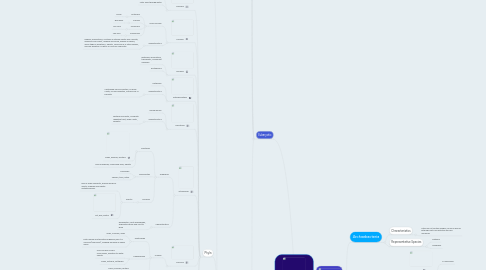
1. Prokaryotic
1.1. Archaebacteria
1.1.1. Characteristics
1.1.1.1. Often do not contain oxygen, found in places with high salt concentration and are unicellular
1.1.2. Representative Species
1.1.2.1. Methane
1.1.2.2. Halophiles
1.2. Eubacteria
1.2.1. Morphology
1.2.1.1. Cocci
1.2.1.1.1. N. gonorrhea
1.2.1.2. Spirilla
1.2.1.2.1. Chlamydia trachomatis
1.2.1.3. Bacilli
1.2.1.3.1. Salmonella
1.2.2. Characteristics
1.2.2.1. Unicellular, cell membrane contains lipids made of glycerolest, lack chloroplasts and mitochondria
2. Eukaryotic
2.1. Fungi
2.1.1. Characteristics
2.1.1.1. Multicellular, do not move, have nuclei, heterotrophic, work in the ecosystem to decompose, recycle nutrients and soil maintenance
2.1.2. Phylas
2.1.2.1. Chytridiomycota (fossil fungus)
2.1.2.1.1. have flagellated spores-Chytrids
2.1.2.2. Zygomycota
2.1.2.2.1. contain sexual spores-Black bread mold
2.1.2.3. Ascomycota (the sac fungi)
2.1.2.3.1. sacs called asci that contain sexual spores-Yeast
2.1.2.4. Basidiomycota (the club fungi-mushrooms)
2.1.2.4.1. club shaped cells called a basidium that contains sexual spores - shelf fungus
2.1.3. Reproductive Strategies
2.1.3.1. Asexual
2.1.3.1.1. Hyphae breaks off releasing spores Spores: are haploid – single set of chromosomes. Spores then germinate, mycelium is produce
2.1.3.2. Sexual
2.1.3.2.1. Spores germinate, the mycelium is formed, plasmogamy occurs and cytoplasm fusses, moves into the heterokaryotic stage, fusion in the nuclei causes zygotes to form then meiosis occurs.
2.2. Plantae
2.2.1. Characteristics
2.2.1.1. autotrophic-photosynthetic, alternations of generations for reproduction, develop from embryos, don’t move and multicellular
2.2.2. Classifications
2.2.2.1. Non-Vascular
2.2.2.1.1. Mosses, liverworts
2.2.2.1.2. non-tracheophytes
2.2.2.2. Vascular
2.2.2.2.1. tracheophytes
2.2.3. Evolutionary Transition From Water To Land
2.2.3.1. To prevent moisture loss- waxy coating, cuticle, stomata
2.2.3.2. Stand upright
2.2.3.3. Conducting tissues for moving nutrients and waste
2.2.3.3.1. Xylem
2.2.3.3.2. Phloem
2.2.3.4. Reproductive strategies
2.3. Protista
2.3.1. Characteristics
2.3.1.1. Live in water, all are eukaryotic, most are unicellular some are multicellularand can be heterotrophic or autotrophic
2.3.2. strategy
2.3.2.1. Feeding Strategy
2.3.2.1.1. Heterotrophic
2.3.2.1.2. Autotrophic
2.3.3. Animal Like Phyla
2.3.3.1. Movement Strategy
2.3.3.1.1. Ciliates-Cilia
2.3.3.1.2. Zooflagellates-Flagella
2.3.3.1.3. Sarcodine-Pseudopods
2.3.4. Plant Like Phyla
2.3.4.1. Chlorophyta
2.3.4.1.1. green algae-Volvox
2.3.4.2. Rhodophyta
2.3.4.2.1. Red algae-Porphyra
2.3.4.3. Phaeophyta
2.3.4.3.1. brown algae-Macrocystis
2.3.4.4. Chrysophyta
2.3.4.4.1. diatoms-Cyclotella
2.3.4.5. Pyrrophyta
2.3.4.5.1. dinoflagellates-Gonyaulax
2.3.4.6. Euglenophyta
2.3.4.6.1. Euglenoids-Euglena
2.3.5. Fungus Like Phyla
2.3.5.1. Molds
2.3.5.1.1. Saprophytic heterotrophs- digesting food externally and then absorbing it
2.3.5.1.2. Types
2.4. Animalia
2.4.1. Characteristics
2.4.1.1. Are eukaryotic, lack cell walls, multicellular, heterotrophic, motile at some point in their life cycle and form a hollow ball of cycles called blastula during embryonic stages.
2.4.2. Phyla
2.4.2.1. Prorifera
2.4.2.1.1. Sponges
2.4.2.1.2. Filter feed through water
2.4.2.2. Cnidaria
2.4.2.2.1. Major Groups
2.4.2.2.2. Characteristics
2.4.2.3. Annelids
2.4.2.3.1. Bilaterally symmetrical, tripoblastic, coelomate organism
2.4.2.3.2. Earthworms
2.4.2.4. Platyhelminthes
2.4.2.4.1. Flatworms
2.4.2.4.2. Characteristics
2.4.2.5. Nematoda
2.4.2.5.1. Round worms
2.4.2.5.2. Characteristics
2.4.2.6. Arthropoda
2.4.2.6.1. Subphylas
2.4.2.6.2. Characteristics
2.4.2.7. Mollusca
2.4.2.7.1. Classes
2.4.2.8. Echinodermata
2.4.2.8.1. Starfish
2.4.2.8.2. radial symmetry, no freshwater or terrestrial representatives
2.4.2.9. Chordata
2.4.2.9.1. Subphyla
2.4.3. Evolutionary Milestone
2.4.3.1. Sponges
2.4.3.1.1. Multicellularity
2.4.3.2. Cnidarians
2.4.3.2.1. Tissues
2.4.3.3. platyhelminthes
2.4.3.3.1. Bilateral Symmetry
2.4.3.4. Nematoda
2.4.3.4.1. Body Cavity
2.4.3.5. Mullusks
2.4.3.5.1. Coelom
2.4.3.6. Annelids
2.4.3.6.1. Segmentation
2.4.3.7. Arthropds
2.4.3.7.1. Jointed Appendages
2.4.3.8. Echinoderms
2.4.3.8.1. Deuterostomes
2.4.3.9. Chordates
2.4.3.9.1. Notocord
2.4.4. adaptations for land conquest
2.4.4.1. Arthropods
2.4.4.1.1. Oxygen without water
2.4.4.1.2. not dry out
